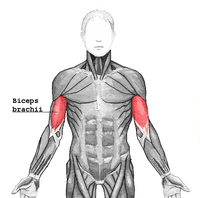Biceps brachii muscle
| Biceps brachii muscle |
|---|

|
| origin |
|
Caput longum : shoulder blade ( tuberculum supraglenoidale ) Caput breve : raven bill process of the shoulder blade ( processus coracoideus scapulae ) |
| approach |
| Radius ( tuberositas radii ) and over aponeurosis m. bicipitis on the antebrachial fascia |
| function |
| Elbow: flexion; Hand: supination; Shoulder joint: anteversion, abduction, fixation of the humeral head (with M. coracoideus) |
| Innervation |
| Musculocutaneous nerve of the brachial plexus |
| Spinal segments |
| C5, C6 |
The biceps brachii muscle ( lat. For "two-headed muscle of the arm"), also called biceps or "arm flexor" for short , is a skeletal muscle of the upper arm . Its two muscle heads, caput longum (long head) and caput breve (short head), arise in humans at different points on the shoulder blade. These two heads gave it its name. Because the deltoid muscle lies above the two heads in this area, the division cannot be seen from the outside. The two muscle heads unite roughly where they are visible to form a single muscle belly and attach to a strong muscle hump (tuberositas radii) of the spoke ( radius ) with a strong tendon below the elbow . A superficial tendon branches off from this tendon, which is known as aponeurosis musculi bicipitis (outdated also Lacertus fibrosus - Latin for sinewy muscle origin) and radiates into the forearm fascia (fascia antebrachii).
In quadruped mammals , the muscle has only one origin at the tuberculum supraglenoidale of the shoulder blade and thus only one head, but from a comparative anatomical point of view it is still referred to as two-headed (biceps).
function
The biceps supinates the forearm (rotation of the forearm from a pronated basic position so that the thumb rotates from the inside outwards around the hand up to a vertical position). If the forearm is already in an extremely supinated position, the biceps can pronate the forearm to the vertical position of the thumb. This effect is known as "active insufficiency" and can be explained by the dwindling torque of the biceps with respect to the axis of rotation. He also bends the forearm at the elbow .
The long head abducts (lifts from the chest ), the short head adducts (leads to the chest) the arm in the shoulder joint . Both heads are involved in the anteversion (moving the arm forward) and in the internal rotation.
In quadruped mammals, the muscle acts as an extensor of the shoulder joint and a powerful flexor of the elbow. Rotary movements play no role in them.
It is the synergist of the brachial muscle and is usually somewhat weaker than this, but the strongest supinator of the forearm. It also acts as an antagonist of the triceps brachii muscle .
Varieties
Sometimes there is a third head of muscle that is covered by the deltoid .
Clinical significance
In the case of a biceps tendon rupture , the attachment or original tendon of the biceps tear as a result of trauma, and in older people also as a result of wear and tear. A dislocation of the tendon of origin is called a pulley lesion .
Even in domestic dogs, biceps tendon dislocation can occasionally occur, which leads to support leg lameness. Inflammation of the tendon of origin and / or its tendon sheath ( tendovaginitis of the biceps brachii muscle ) is observed primarily in older, medium-sized to large dogs and leads to increasing lameness of the forelegs, which worsens under load.
In the case of the dead, an idiomuscular bulge can be triggered with a reflex hammer within the first 8 hours .
Web links
Individual evidence
- ^ Ernst-Günther Grünbaum: Clinic of dog diseases . Georg Thieme, Stuttgart 2007, ISBN 9783830410218 .
